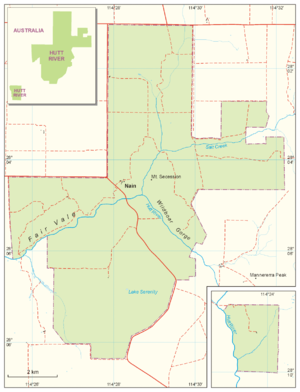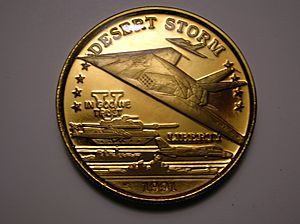Principality of Hutt River facts for kids
Quick facts for kids Principality of Hutt River |
||
| Micronation | ||
| Motto: Dum Spiro Spero
(While I Breathe, I Hope) |
||
| Status | Current | |
|---|---|---|
| Location | 28°4′28″S 114°28′14.5″E / 28.07444°S 114.470694°E | |
| Area claimed | 75 Km2
(18,533 Acres) |
|
| Population | 30 full time residents, 13,000-18,000 overseas citizens |
|
| Date of foundation | 21 April 1970 | |
| Leadership | Prince Prince Ian | |
| Organizational structure | Principality | |
| Language | English (official language) French, Esperanto (per constitution) |
|
| Purported currency | Hutt River Dollar, tied 1:1 with Australian Dollar | |
| Capital | Nain | |
| Ethnic groups | Caucasian, Australian Aborigines (Nunda Tribe) | |
| Demonym | Hutt River citizens | |
| Time zone | UTC+08:00 | |
The Principality of Hutt River, once called the Hutt River Province, is the oldest micronation in Australia. A micronation is like a small, self-declared country that isn't officially recognized by other big countries. The Principality of Hutt River says it's an independent state. Most countries don't agree, but it gained a kind of legal status on April 21, 1972.
This small "country" is located about 517 kilometers (321 miles) north of Perth, near the town of Northampton.
It was started on April 21, 1970, by Leonard George Casley. He and his friends announced they were breaking away from the state of Western Australia. This act of breaking away is called secession.
Contents
How Did Hutt River Start?
The Principality of Hutt River began in 1969. It was first called Hutt River Province. This happened because of a big disagreement with the government of Western Australia. The Casley family thought the rules about how much wheat they could grow and sell were very unfair.
Their farm had about 4,000 hectares (10,000 acres) of wheat ready. But new rules meant they could only sell a tiny amount. Leonard Casley and five other farming families joined together. They wanted to fight these new rules.
Casley sent a complaint to the Governor of Western Australia. The Governor said no changes would be made. Because the Governor represents Queen Elizabeth II, Casley believed the Queen was responsible for this unfair rule.
He then asked for $52 million in damages. He hoped this would make the government change the wheat rules. Instead, the government tried to take their land. This is called eminent domain or compulsory acquisition.
After trying to get the government to change its mind, Casley and his friends used an old British law. They felt this law allowed them to declare independence from Australia. Casley always said he remained loyal to Queen Elizabeth II. His family then chose him to lead their new "sovereign state."
Becoming a Principality
The government of Western Australia wasn't sure what to do. The Governor-General of Australia, Sir Paul Hasluck, later said that the national government couldn't interfere with the secession. By mistake, the Governor-General's office called Casley the "Administrator of the Hutt River Province" in letters. This small mistake was seen as a form of official recognition.
When the government threatened to charge him, Casley changed his title. He called himself His Royal Highness Prince Leonard I of Hutt. He did this because of an old law. This law said a monarch (a king or queen) could not be charged with crimes. It also said anyone who stopped a monarch from doing their duties could be charged with treason.
Even though this law has changed, the Australian government hasn't taken action against Hutt River since then. Under Australian law, the government had two years to respond to Casley's declaration. Because they didn't respond, the province gained a de facto (meaning "in fact" or "in practice") legal status on April 21, 1972.
In 1976, Australia Post stopped handling mail from Hutt River. Mail had to be sent through Canada instead. In 1977, after being asked to pay taxes by the Australian Taxation Office (ATO), the province declared war on Australia. Prince Leonard ended the "war" a few days later. After this, mail service was restored, and tax requests stopped.
Today, the ATO sees Hutt River citizens as non-residents of Australia for income tax. This means money earned in the principality is free from Australian taxes. The principality collects its own small tax of 0.5% on some financial deals.
The Australian government officially sees Hutt River as a private business.
In the early 1980s, Hutt River Province called itself a kingdom. But it soon went back to being a principality. It also started making its own stamps and coins. In 2006, Prince Leonard changed the name to "Principality of Hutt River," dropping the word "Province."
Facts About Hutt River
The Principality of Hutt River is located 517 kilometers (321 miles) north of Perth. It sits along the Hutt River. Its total size is about 75 square kilometers (18,533 acres).
Hutt River sells things like wildflowers, farm products, stamps, and coins to other places. Tourism is also important, with about 40,000 visitors each year.
Very few people live in Hutt River full-time. However, the principality claims to have 13,000 citizens around the world.
The Principality doesn't have a regular army. But some citizens have been given military titles. Special guards attend the prince on important days. Even though it's completely surrounded by land, some supporters have been given naval titles.
The capital city of the principality is called Nain. It's named after a town in Galilee, Nain.
How Hutt River Is Governed
When the Principality of Hutt River first broke away, they wrote a bill of rights. This short paper explained the basic rights of Hutt River citizens. It also set up a temporary board to run the principality.
When Casley declared himself a prince, this board was removed. The Hutt River Principality became a kind of absolute monarchy. This means the prince had all the power. A special committee was set up to write new laws.
In 1997, this committee suggested a constitution to the prince and his cabinet (a group of advisors). The newest version of this constitution started on January 1, 2011. All citizens over 18 who live in the principality can vote for their parliament.
The Royal Family
His Royal Highness Prince Leonard I of Hutt was the title used by Leonard George Casley. He started the Hutt River Principality. Prince Leonard was married to Her Royal Highness Princess Shirley of Hutt. They had seven children. Their son, Crown Prince Ian (born in 1947), is the Prime Minister of the Principality. He is also Prince Leonard's heir apparent, meaning he was next in line to become prince.
Prince Leonard passed away from a lung infection on February 13, 2019, at 93 years old.
Prince Ian is very involved in growing and selling wildflowers. These flowers are sent to Perth and many other cities around the world.
Princess Shirley welcomed many important guests and reporters to the principality each year. She was also a royal patron and leader of the Red Cross of Hutt.
The royal family has 24 grandchildren and 23 great-grandchildren.
Before buying a large wheat farm in the 1960s, Prince Leonard had many jobs. He was a mathematician and physicist who worked for NASA in the 1950s. A star has even been named in his honor.
Prince Leonard was known as a very smart "bush lawyer." This means he was good at understanding and using laws. He was also interested in hermeticism, a special kind of philosophy. He wrote several books and papers about it.
There is a permanent exhibit about Prince Leonard at the National Museum of Australia in Canberra.
Hutt River Money
Hutt River started using its own banknotes in 1974. The first Hutt River coins were made in 1976.
The money of the Hutt River Principality is called the Hutt River Dollar. It is divided into 100 cents. One Hutt River Dollar is worth the same as one Australian dollar.
Early Coins: 1976 - 1978
The first coins came in four values: 5 cents, 10 cents, 20 cents, and 50 cents. These were made between 1976 and 1978. There were also special $30 silver coins and $100 gold coins made for collectors.
| First Series | |||||||
|---|---|---|---|---|---|---|---|
| Value | Technical parameters | Description | Date of first minting | ||||
| Diameter | Composition | Edge | Obverse | Reverse | |||
| 5¢ | 16.5 mm | Aluminium | Plain | Prince Leonard | Coat of arms | 1976 | |
| 10¢ | 19.1 mm | Copper | |||||
| 20¢ | 22.4 mm | Brass | |||||
| 50¢ | 24.9 mm | Cupronickel | |||||
| $30 | 38.1 mm | 999‰ silver | Reeded | ||||
| $100 | 25 mm | 24 carat gold | Plain | ||||
Special $1 Coin
In 1977, $1 coins were made to celebrate the Silver Jubilee of Elizabeth II (25 years of Queen Elizabeth II's reign). These coins are sometimes called "holey dollars" because they had a hole in the middle, like some very rare old coins.
Coins with the same design were made again in 1978, but without the "Queen's Jubilee" writing.
Newer Coins
Most of the coins made later were special collector's items. They often celebrated specific events and were usually made from precious metals like silver or gold. Coins were made until 2000, and then again starting in 2007. The 2007 coins celebrated the 60th wedding anniversary of the Prince and Princess.
What Is Hutt River's Official Status?
The Australian government does not officially recognize the "Hutt River Province." The Australian Ambassador to the United Arab Emirates said that the land is just a private wheat farm. He stated it has no special status and is still under Australian law. He also said the Australian government does not recognize the "royal titles" or other official titles used by the family.
However, the Principality of Hutt River argues that it is an independent place within Australia's legal system. They say the Australian government cannot deny the "de facto" legal status it gained by mistake. They believe overturning this would be difficult because of legal questions about how Western Australia became British Territory.
Even though Australian law doesn't officially recognize Hutt River passports, they have sometimes been accepted for travel overseas.
In 2010, a Western Australian minister was asked about the province. He said Prince Leonard was a "mystery" but that the issue wasn't on his agenda.
How Australian Government Departments Treat Hutt River
Generally, Australian government departments don't interfere with Hutt River Province. The ATO has warned people not to buy companies from Hutt River. But it hasn't taken direct action against the principality.
Hutt River had plans to start a university in its territory, which is usually illegal in Australia. However, the government didn't stop them. Also, Hutt River does not pay taxes to the ATO.
How European Governments Treat Hutt River
In 2008, the Council of the European Union listed Hutt River passports as "fantasy passports." These are issued by private groups and individuals. The Council said that visas should not be put on such passports.
Images for kids
-
Front side of a 50-cent coin showing Casley
See also
 In Spanish: Principado de Hutt River para niños
In Spanish: Principado de Hutt River para niños








